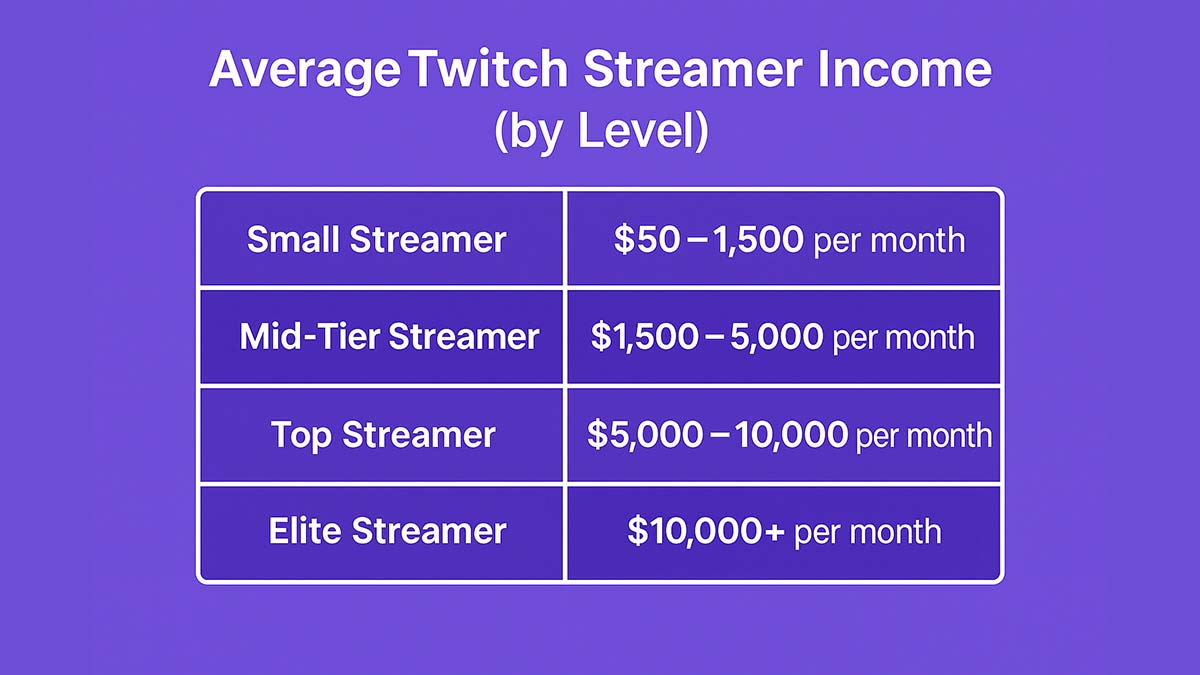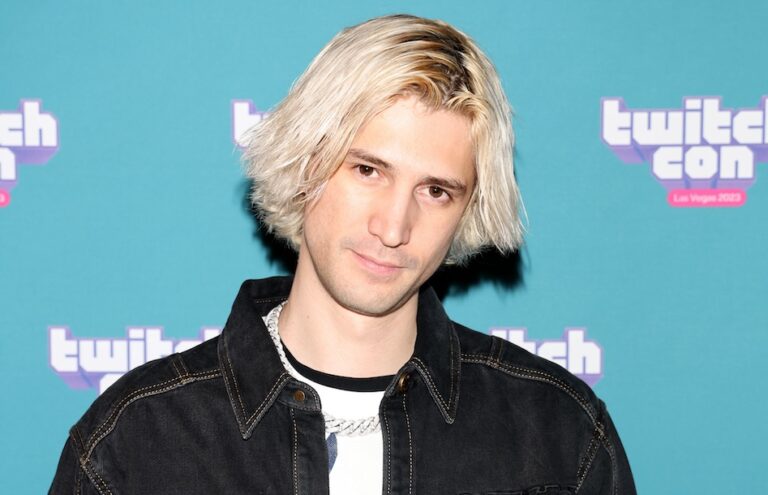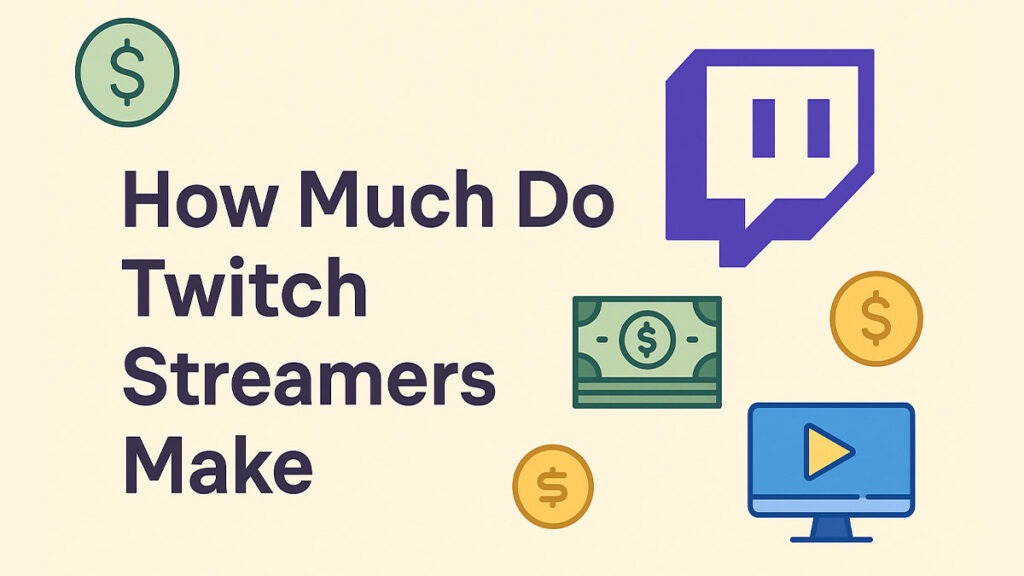If you’ve ever watched a Twitch streamer and thought, “Wow, I wonder how much they’re making,” you’re not alone. It’s something almost everyone who spends time on Twitch has asked at least once.
Some people stream just for fun. Others make a living from it — and a few are earning more than most full-time jobs. But figuring out how much Twitch streamers make isn’t as simple as it sounds.
There’s no fixed salary, no guaranteed income. Some streamers pull in a few bucks a month, others make thousands through a mix of subs, ads, donations, and sponsorships. It’s part art, part business, and part persistence.
In this guide, we’ll break down how Twitch streamers actually earn money — from subscriptions and Bits to brand deals and affiliate links. You’ll also learn how much Twitch streamers make per sub, how much they make per ad, and even a few tips on how to make money on Twitch if you’re thinking about starting your own channel.
By the end, you’ll have a clearer idea of what’s realistic on Twitch — and what it takes to go from streaming as a hobby to turning it into real income.
How Twitch Streamers Make Money
So, let’s get into it — how do Twitch streamers actually make money?
It’s not just about going live and waiting for Twitch to send a paycheck. In fact, Twitch doesn’t really “pay” you directly unless you’re part of their Affiliate or Partner programs. Most income comes from multiple sources that add up over time — subs, ads, Bits, sponsorships, donations, and a few clever extras.
Here’s a breakdown of where the money really comes from.
1. Subscriptions
Subscriptions are the backbone of a Twitch streamer’s income. Viewers pay to support a channel and, in return, get perks like custom emotes and ad-free viewing.
There are three subscription tiers: $4.99, $9.99, and $24.99 per month. Most streamers get 50% of that, while bigger names sometimes earn 70%.
So, if you’ve ever wondered how much do Twitch streamers make per sub, here’s a quick look:
- Tier 1 ($4.99) → about $2.50 to the streamer
- Tier 2 ($9.99) → about $5
- Tier 3 ($24.99) → about $12.50
It might not sound huge, but when you start stacking hundreds or even thousands of subscribers, it adds up fast.
2. Bits (Cheering)
Bits are Twitch’s built-in “tip” system. Viewers buy Bits from Twitch and use them to cheer during streams.
Every Bit is worth $0.01, so 100 Bits equals $1. It’s not life-changing money, but over dozens of streams and hundreds of viewers, it becomes a nice bonus.
Bits are popular because they’re fun and interactive — viewers get recognized in chat, and streamers get paid without dealing with third-party tip platforms.
3. Ads
Ah, the classic question — how much do Twitch streamers make per ad?
Twitch runs ads before or during streams, and streamers earn based on views and ad rates (called CPM, or cost per thousand views). Most Twitch creators make anywhere between $3 and $10 per 1,000 ad views, depending on factors like their audience’s location and engagement.
For small streamers, ad income is minor. But once you’ve got hundreds or thousands of viewers tuning in daily, those short ad breaks can turn into a steady stream of extra income.
4. Donations and Tips
This is one of the most direct ways for viewers to support a streamer.
Donations usually come through platforms like PayPal, Streamlabs, or Ko-fi, which means Twitch doesn’t take a cut. Fans can send anything from a few dollars to hundreds — especially during hype moments or charity streams.
It’s unpredictable, but it’s also one of the most personal ways creators earn. And sometimes, a single generous fan can make a huge difference.
5. Sponsorships and Brand Deals
Once a streamer builds a strong following, brands start to notice.
A gaming creator might get a deal with a PC hardware company. A lifestyle streamer might partner with a skincare or fashion brand. Sponsorships can pay anywhere from a few hundred dollars for smaller channels to tens of thousands for top creators.
It’s one of the best ways to scale your income beyond Twitch’s built-in features — especially for those who know how to market themselves.
6. Affiliate Marketing
Affiliate marketing is another clever income stream.
Streamers promote products — like their favorite mouse, headset, or energy drink — and earn a commission each time someone buys through their link.
For creators who want to learn how to make money on Twitch without relying only on subs or ads, affiliate marketing is one of the easiest and most sustainable ways to start.
7. Merchandise
Many streamers eventually launch branded T-shirts, hoodies, mugs, or stickers. It’s both a money-maker and a way to connect with fans beyond the screen. Most use platforms like StreamElements, Fourthwall, or Teespring, which handle everything from printing to shipping.
Even if it’s not the biggest income source, merch helps strengthen your brand — and gives loyal viewers something tangible to support.
In short, how Twitch streamers make money comes down to building multiple income streams that work together. Subs, ads, sponsorships, donations, affiliates — it all blends into one ecosystem.
And that’s why there’s no single answer to how much do Twitch streamers make. It depends on how creative and consistent you are with turning your audience into a community that supports you.
Average Twitch Streamer Income (by Level)

Now that you know how Twitch streamers make money, let’s talk numbers.
Because that’s what everyone really wants to know — how much do Twitch streamers make on average?
The truth is, it varies a lot. Twitch income depends on a bunch of things — how big your audience is, how often you stream, where your viewers are from, and how you mix your income sources.
Still, you can get a decent idea by looking at what streamers at different levels are earning today.
1. Beginner Streamers (0–100 average viewers)
If you’re new to Twitch, it’s totally normal to earn just a little at first.
Most small creators make somewhere between $50 and $500 a month.
That usually comes from a few subscriptions, some small donations, and maybe a few ad views.
Here’s what a typical beginner setup might look like:
Not huge money, but it’s a start. And honestly, that first payout feels amazing. It’s proof that people value what you’re doing.
2. Mid-Tier Streamers (100–1,000 average viewers)
This is where streaming starts to look like a real job.
Streamers with steady audiences in this range usually make $1,000 to $10,000 a month, depending on consistency and engagement.
Here’s a quick example:
By this stage, most creators have built a loyal community. They’ve probably figured out how to make money on Twitch playing games, chatting, or mixing both.
It’s not easy, but it’s where effort finally starts paying off.
3. Top Streamers (1,000+ average viewers)
Once you hit this level, Twitch can easily turn into a full-time career.
Top creators often earn $20,000 to $100,000+ per month, depending on their audience size, brand deals, and off-platform income like YouTube or merch.
Here’s a general idea:
At this level, streamers aren’t just entertainers. They’re brands. Their income doesn’t come from Twitch alone — it’s built on relationships, recognition, and reputation.
4. Elite Streamers (Twitch Celebrities)
Then you have the top of the mountain — the Twitch stars everyone knows by name.
Creators like xQc, Pokimane, Kai Cenat, and Shroud earn millions of dollars per year. And that’s not just from Twitch.
They make serious money from sponsorships, YouTube, merch, appearances, and exclusive streaming deals.
At this point, Twitch is less of a platform and more of a launchpad for a whole business.
Quick Snapshot: How Much Do Twitch Streamers Make (2025)
| Streamer Level | Average Viewers | Est. Monthly Income | Main Income Sources |
|---|---|---|---|
| Beginner | 0–100 | $50–$500 | Subs, small tips |
| Mid-tier | 100–1,000 | $1,000–$10,000 | Subs, ads, donations |
| Top Streamer | 1,000+ | $20,000–$100,000+ | Subs, ads, sponsorships |
| Elite | 10,000+ | $500,000+/year | Brand deals, merch, contracts |
So, how much do Twitch streamers make overall?
Anywhere from pocket money to millionaire status — it all depends on your consistency, your audience, and how well you combine your income sources.
Twitch isn’t a paycheck. It’s a platform.
And for those who stick with it, that platform can grow into something much bigger than just streaming.
Twitch Partner vs Affiliate – Who Earns More?
If you’ve spent any time on Twitch, you’ve probably heard the terms Affiliate and Partner. They’re the two main levels of monetization on the platform, and they play a big role in how much Twitch streamers make.
But what’s the actual difference between the two — and who ends up earning more? Let’s break it down.
Twitch Affiliate: The First Step Toward Earning
Becoming a Twitch Affiliate is the first real milestone for most streamers. It’s the moment when Twitch officially lets you start earning.
To qualify, you need to:
Once you hit those numbers, Twitch gives you access to:
Affiliates typically earn around 50% of each subscription, which means about $2.50 for every $4.99 sub.
That’s where most creators start making their first few dollars on the platform. But there’s a ceiling — and that’s where the Partner program comes in.
Twitch Partner: The Next Level
The Twitch Partner status is like unlocking the pro version of the platform. It’s invite-only, and you need to meet higher performance metrics:
Partners get everything Affiliates do, plus a bunch of upgrades:
While the average Affiliate might earn a few hundred dollars a month, a mid-level Partner can easily make $1,000–$10,000 per month or more, depending on audience size and activity.
It’s the same platform, but the income potential jumps dramatically once you have that Partner badge.
Affiliate vs Partner: Quick Comparison
| Feature | Twitch Affiliate | Twitch Partner |
|---|---|---|
| Qualification | 50 followers, 3 avg. viewers | 75+ avg. viewers, invite-only |
| Revenue Split (Subs) | 50/50 | Up to 70/30 |
| Ad Control | Limited | Full control |
| Support | Standard | Priority |
| Sponsorship Access | Limited | High-value brand deals |
| Average Monthly Income | $50–$1,000 | $1,000–$10,000+ |
So, Who Earns More?
In short, Partners earn more — often a lot more.
They have better deals, more exposure, and access to higher-paying sponsorships.
But here’s the thing: it’s not just about the badge. It’s about the community behind it.
Even some Affiliates with small but loyal audiences can earn a steady income, while some Partners with big audiences struggle to keep engagement up. Twitch rewards consistency, not just numbers.
So if you’re starting out, focus less on “how much do Twitch streamers make” and more on how they build communities that stick around. Once that part clicks, the money follows naturally.
Real-World Examples of Top Twitch Streamers
We’ve talked about averages and income ranges, but nothing explains how much Twitch streamers make better than real examples.
Let’s look at a few well-known names who’ve turned streaming into serious income — and what’s actually behind those numbers.
1. xQc – The Power Streamer

It’s hard to talk about Twitch without mentioning xQc (Félix Lengyel).
He’s one of the biggest names on the platform, with millions of followers and thousands of viewers tuning in every single day.
Back in 2021, leaked Twitch payout data showed that xQc made over $8 million in two years, just from Twitch alone.
That doesn’t even include sponsorships, YouTube revenue, or merch.
Today, his income likely sits somewhere between $200,000 and $300,000 per month when you combine all his revenue sources.
What drives that?
Consistency. He streams for hours every day, engages constantly with his chat, and stays active across platforms. It’s a reminder that streaming success isn’t luck — it’s stamina.
2. Pokimane – The All-Around Creator

Pokimane (Imane Anys) is another Twitch legend. She’s known for gaming, chatting, and her easygoing personality that connects instantly with viewers.
Her Twitch earnings are estimated at $20,000 to $40,000 per month, depending on her activity, but her total monthly income goes much higher once you factor in YouTube, brand partnerships, and sponsorships.
Pokimane has built more than just a Twitch channel — she’s built a personal brand.
She often talks openly about how to make money on Twitch as a woman in a competitive space, and her approach blends authenticity with smart business.
3. Kai Cenat – The Breakout Star

Kai Cenat represents the new generation of streamers who’ve exploded in popularity thanks to a mix of humor, energy, and smart collaborations.
In 2023, Kai reportedly earned over $3 million in a single month after breaking Twitch’s all-time sub record. His streams are a mix of comedy, celebrity guests, and nonstop entertainment — which keeps his audience hooked.
For Kai, Twitch isn’t just a platform. It’s a stage.
He’s living proof that the ceiling for how much Twitch streamers can make keeps getting higher when you mix creativity with community.
4. Shroud – The Esports Veteran

Shroud (Michael Grzesiek) built his reputation as one of the best FPS gamers in the world. After switching from professional esports to full-time streaming, he quickly became one of Twitch’s top earners.
His estimated Twitch income sits around $80,000 to $100,000 per month, but when you add in sponsorships, YouTube revenue, and brand deals, it can easily cross several hundred thousand.
What makes Shroud’s success stand out is his focus on skill and quality. He’s not flashy or loud — he’s consistent, calm, and highly respected in the gaming world.
What These Streamers Teach Us
Each of these streamers took a different path, but they all share a few things in common:
So when people ask how much do Twitch streamers make, the real answer is this:
It depends on how much effort, creativity, and consistency you’re willing to invest.
Twitch can be unpredictable, but it rewards those who stay genuine and show up every single day.
Factors That Affect Earnings
We’ve seen that how much Twitch streamers make can vary wildly — from a few dollars a month to life-changing income. But what actually determines which end of that range you hit?
It’s not just luck or talent. A handful of core factors shape every streamer’s earning potential.
In Short: What Impacts Twitch Income
| Factor | Why It Matters |
|---|---|
| Audience Size & Engagement | Loyal fans drive subs and growth |
| Consistency | Builds visibility and habits |
| Content Type | Some niches attract better sponsors |
| Viewer Location | Ad rates vary by country |
| Community Support | Direct donations create stability |
| Sponsorships | Add scalable income potential |
| Diversification | Expands reach and revenue |
| Personality | Keeps your channel memorable |
So, how much do Twitch streamers make really depends on how they manage all these moving parts.
It’s not just about numbers — it’s about showing up, connecting with people, and building something that feels real.
When you combine consistency with personality, that’s when the numbers start to move.
How Twitch Payouts Work
Once you start earning from subs, ads, and donations, the next big question is: when does Twitch actually pay you?
Understanding how Twitch payouts work helps you plan ahead — especially if you want to treat streaming as a real source of income.
Who Gets Paid
Only Twitch Affiliates and Partners can earn directly through Twitch.
If you’re not there yet, you can still earn through external options like PayPal or Streamlabs, but Twitch itself starts paying once you reach Affiliate status.
After that, Twitch tracks all your income — subs, Bits, and ad revenue — automatically in your Creator Dashboard.
Minimum Payout and Schedule
Twitch pays you once you’ve earned at least $50.
If you don’t hit that in a given month, your balance rolls over until you do.
Payouts are processed once a month, usually about 15 days after the month ends.
For example, if you earn $60 in March, you’ll likely see it around mid-April.
It’s not instant, but it’s consistent — which helps when you’re managing your budget.
Payment Methods
Twitch supports a few different payment options depending on your location:
Double-check your payment details before payout time. Most delays happen due to incorrect info.
Twitch’s Cut
Twitch takes a share of what you earn.
In short, Twitch earns when you earn — standard for creator platforms.
Taxes and Delays
Your Twitch income is taxable, just like freelance income.
U.S. creators fill out a W-9, and international creators submit a W-8BEN for tax treaty purposes.
Delays can happen due to:
Twitch’s Creator Support usually resolves issues fast.
So when people ask how much do Twitch streamers make, the real story isn’t just about how much they earn — it’s about how they manage it.
Twitch income can be steady one month and unpredictable the next. Knowing how payouts work keeps you in control, no matter how big (or small) your channel is right now.
Can You Make a Living from Twitch?
Let’s be real — everyone wonders if streaming can actually pay the bills.
The short answer: yes, it’s possible.
The long answer: it’s hard work.
It’s Possible, But Takes Time
Twitch has turned thousands of creators into full-time streamers. Some make a steady living from subs, donations, and sponsorships. But for every success story, there are many still grinding to grow their audience.
Twitch isn’t a job with a paycheck — it’s a platform where your income depends on effort, connection, and consistency.
Income Fluctuates
Even top streamers have good months and slow ones. Viewership drops, ad rates change, and subs expire. That’s why most creators don’t rely only on Twitch.
They diversify — with YouTube, Patreon, merch, or brand deals — to keep income steady.
If you want to make streaming sustainable, think bigger than just Twitch.
Consistency and Personality Win
You don’t need fancy gear or pro-level skills. What matters is showing up regularly and being yourself.
Viewers support creators they feel connected to. That’s why even smaller channels with loyal fans can earn steady income — because they’ve built real communities, not just view counts.
Avoid Burnout
Streaming full-time can be draining. You’re performing, chatting, and entertaining for hours.
To last long-term, treat streaming like a creative career, not a sprint. Take breaks. Keep it fun.
Yes, you can make a living on Twitch — but it takes patience, consistency, and smart planning.
Treat your stream like a small business. Build trust, show up, and create value for your community.
The money follows those who stick around long enough to earn it.
Final Thoughts – Turning Passion into Paychecks
When people ask how much do Twitch streamers make, they usually picture the big numbers — the sponsors, subs, and fame. And yes, some do reach that level. But behind every “overnight success” is a long grind filled with small wins, slow growth, and a lot of showing up.
Most streamers start small — a few viewers, a handful of regulars, and plenty of quiet streams. Over time, that builds into something real. That’s the real Twitch story: not luck, but persistence.
The best creators don’t chase payouts — they build communities.
Money follows authenticity. When viewers feel you’re there for them, they stick around, support you, and help your channel grow.
Whether you’re figuring out how to make money on Twitch or just streaming for fun, focus on connection first. The income comes later.
Every stream is practice. Every chat is feedback.
You’re not just playing a game — you’re creating an experience.
Keep improving your setup, your energy, and your delivery.
You don’t need perfection — just progress, one stream at a time.
Every streamer starts somewhere. Keep showing up, keep learning, and eventually, you’ll turn your passion into paychecks — one viewer, one sub, and one stream at a time.
